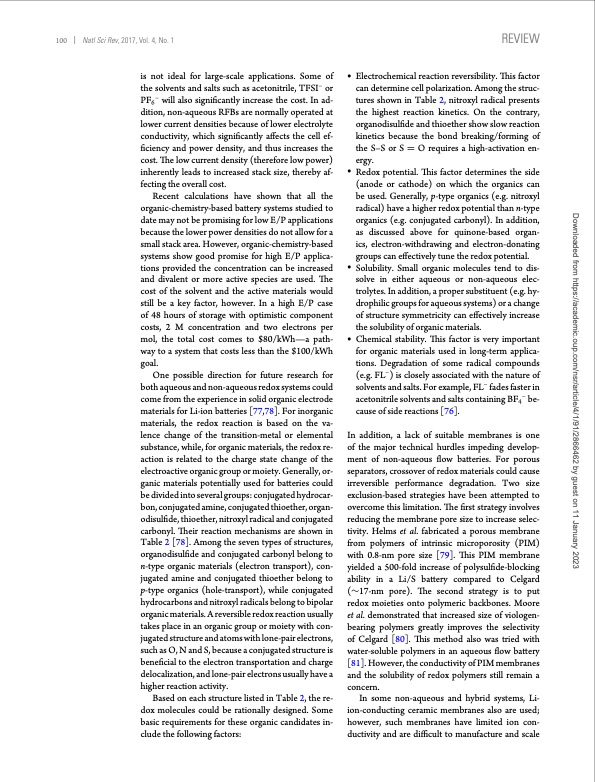
PDF Publication Title:
Text from PDF Page: 010
100 Natl Sci Rev, 2017, Vol. 4, No. 1 REVIEW is not ideal for large-scale applications. Some of the solvents and salts such as acetonitrile, TFSI– or PF6– will also significantly increase the cost. In ad- dition, non-aqueous RFBs are normally operated at lower current densities because of lower electrolyte conductivity, which significantly affects the cell ef- ficiency and power density, and thus increases the cost. The low current density (therefore low power) inherently leads to increased stack size, thereby af- fecting the overall cost. Recent calculations have shown that all the organic-chemistry-based battery systems studied to date may not be promising for low E/P applications because the lower power densities do not allow for a small stack area. However, organic-chemistry-based systems show good promise for high E/P applica- tions provided the concentration can be increased and divalent or more active species are used. The cost of the solvent and the active materials would still be a key factor, however. In a high E/P case of 48 hours of storage with optimistic component costs, 2 M concentration and two electrons per mol, the total cost comes to $80/kWh—a path- way to a system that costs less than the $100/kWh goal. One possible direction for future research for both aqueous and non-aqueous redox systems could come from the experience in solid organic electrode materials for Li-ion batteries [77,78]. For inorganic materials, the redox reaction is based on the va- lence change of the transition-metal or elemental substance, while, for organic materials, the redox re- action is related to the charge state change of the electroactive organic group or moiety. Generally, or- ganic materials potentially used for batteries could be divided into several groups: conjugated hydrocar- bon, conjugated amine, conjugated thioether, organ- odisulfide, thioether, nitroxyl radical and conjugated carbonyl. Their reaction mechanisms are shown in Table 2 [78]. Among the seven types of structures, organodisulfide and conjugated carbonyl belong to n-type organic materials (electron transport), con- jugated amine and conjugated thioether belong to p-type organics (hole-transport), while conjugated hydrocarbons and nitroxyl radicals belong to bipolar organic materials. A reversible redox reaction usually takes place in an organic group or moiety with con- jugated structure and atoms with lone-pair electrons, such as O, N and S, because a conjugated structure is beneficial to the electron transportation and charge delocalization, and lone-pair electrons usually have a higher reaction activity. Based on each structure listed in Table 2, the re- dox molecules could be rationally designed. Some basic requirements for these organic candidates in- clude the following factors: r Electrochemical reaction reversibility. This factor can determine cell polarization. Among the struc- tures shown in Table 2, nitroxyl radical presents the highest reaction kinetics. On the contrary, organodisulfide and thioether show slow reaction kinetics because the bond breaking/forming of the S–S or S = O requires a high-activation en- ergy. r Redox potential. This factor determines the side (anode or cathode) on which the organics can be used. Generally, p-type organics (e.g. nitroxyl radical) have a higher redox potential than n-type organics (e.g. conjugated carbonyl). In addition, as discussed above for quinone-based organ- ics, electron-withdrawing and electron-donating groups can effectively tune the redox potential. r Solubility. Small organic molecules tend to dis- solve in either aqueous or non-aqueous elec- trolytes. In addition, a proper substituent (e.g. hy- drophilic groups for aqueous systems) or a change of structure symmetricity can effectively increase the solubility of organic materials. r Chemical stability. This factor is very important for organic materials used in long-term applica- tions. Degradation of some radical compounds (e.g. FL–) is closely associated with the nature of solvents and salts. For example, FL– fades faster in acetonitrile solvents and salts containing BF4– be- cause of side reactions [76]. In addition, a lack of suitable membranes is one of the major technical hurdles impeding develop- ment of non-aqueous flow batteries. For porous separators, crossover of redox materials could cause irreversible performance degradation. Two size exclusion-based strategies have been attempted to overcome this limitation. The first strategy involves reducing the membrane pore size to increase selec- tivity. Helms et al. fabricated a porous membrane from polymers of intrinsic microporosity (PIM) with 0.8-nm pore size [79]. This PIM membrane yielded a 500-fold increase of polysulfide-blocking ability in a Li/S battery compared to Celgard (∼17-nm pore). The second strategy is to put redox moieties onto polymeric backbones. Moore et al. demonstrated that increased size of viologen- bearing polymers greatly improves the selectivity of Celgard [80]. This method also was tried with water-soluble polymers in an aqueous flow battery [81]. However, the conductivity of PIM membranes and the solubility of redox polymers still remain a concern. In some non-aqueous and hybrid systems, Li- ion-conducting ceramic membranes also are used; however, such membranes have limited ion con- ductivity and are difficult to manufacture and scale Downloaded from https://academic.oup.com/nsr/article/4/1/91/2866462 by guest on 11 January 2023PDF Image | Progress in low cost redox flow batteries energy storage

PDF Search Title:
Progress in low cost redox flow batteries energy storageOriginal File Name Searched:
nww098.pdfDIY PDF Search: Google It | Yahoo | Bing
Salgenx Redox Flow Battery Technology: Salt water flow battery technology with low cost and great energy density that can be used for power storage and thermal storage. Let us de-risk your production using our license. Our aqueous flow battery is less cost than Tesla Megapack and available faster. Redox flow battery. No membrane needed like with Vanadium, or Bromine. Salgenx flow battery
| CONTACT TEL: 608-238-6001 Email: greg@salgenx.com | RSS | AMP |